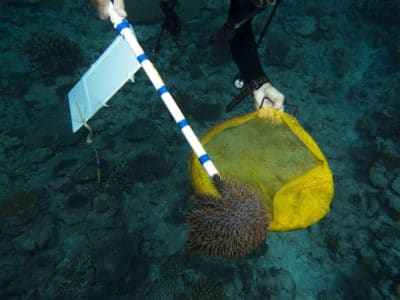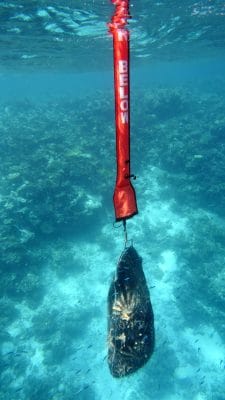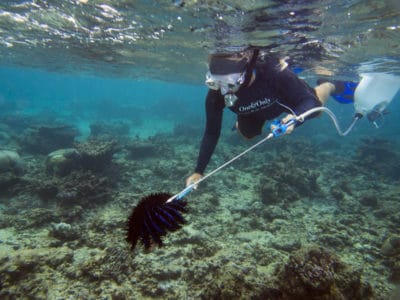Managing a COTS Outbreak
Best Management Practices
 Crown-of-thorns starfish (COTS) are naturally occurring organisms on the reefs of the Indo-Pacific Ocean that primarily eat coral. Finding a few COTS living on a coral reef is a normal and healthy part of the coral reef ecosystem. However, at times their population can drastically exceed normal levels and a COTS outbreak can occur. COTS outbreaks can cause extremely rapid destruction of coral reef ecosystems in matter of months. In recent years, COTS outbreaks have increased in scale and frequency, causing marine resource managers and scientists to take action. The goal of COTS management is to reduce or prevent the damaging impacts of an outbreak and will require constant monitoring in the future. The Khaled bin Sultan Living Oceans Foundation (KSLOF) has come across several COTS infested reefs throughout the Global Reef Expedition in the Indo-Pacific. We have used a variety of different methods for collecting and disposing of COTS and have developed a list of COTS best management practices.
Crown-of-thorns starfish (COTS) are naturally occurring organisms on the reefs of the Indo-Pacific Ocean that primarily eat coral. Finding a few COTS living on a coral reef is a normal and healthy part of the coral reef ecosystem. However, at times their population can drastically exceed normal levels and a COTS outbreak can occur. COTS outbreaks can cause extremely rapid destruction of coral reef ecosystems in matter of months. In recent years, COTS outbreaks have increased in scale and frequency, causing marine resource managers and scientists to take action. The goal of COTS management is to reduce or prevent the damaging impacts of an outbreak and will require constant monitoring in the future. The Khaled bin Sultan Living Oceans Foundation (KSLOF) has come across several COTS infested reefs throughout the Global Reef Expedition in the Indo-Pacific. We have used a variety of different methods for collecting and disposing of COTS and have developed a list of COTS best management practices.
Physical Removal
 The Khaled bin Sultan Living Oceans Foundation recommends the physical removal of COTS from the reef. Experienced divers can use a wooden stick, PVC pipe, metal spear, boat hook or some other easily manipulated rod to remove the starfish off the reef. COTS have the ability to hide in small holes or crevices by using their tubefeet to suction onto the reef. This can make collecting COTS challenging, that is why using a rod or stick to pry the starfish off the reef is the best tool. The collected starfish can be placed in large canvas bags, rice/flour bags or mesh bags and brought to the boat or shore. The sharp poisonous spines of the starfish can penetrate the bag so please use caution. The process can be facilitated by locating a small boat near the divers, with bags of starfish sent to the surface using ropes or lift bags. In shallow water, starfish can be removed by snorkeling, but SCUBA is more effective.
The Khaled bin Sultan Living Oceans Foundation recommends the physical removal of COTS from the reef. Experienced divers can use a wooden stick, PVC pipe, metal spear, boat hook or some other easily manipulated rod to remove the starfish off the reef. COTS have the ability to hide in small holes or crevices by using their tubefeet to suction onto the reef. This can make collecting COTS challenging, that is why using a rod or stick to pry the starfish off the reef is the best tool. The collected starfish can be placed in large canvas bags, rice/flour bags or mesh bags and brought to the boat or shore. The sharp poisonous spines of the starfish can penetrate the bag so please use caution. The process can be facilitated by locating a small boat near the divers, with bags of starfish sent to the surface using ropes or lift bags. In shallow water, starfish can be removed by snorkeling, but SCUBA is more effective.
Once the starfish are removed from the water, the animals can be disposed of on land by burning or burial. The COTS can be used as fertilizer or compost if they are buried in soil. If you are out at sea on a ship or boat, fill a large container with fresh water and submerge the COTS for at least 48 hours. After sufficient time has passed, it is safe to dispose the starfish over open ocean no less than 50 miles off shore. The advantages of this method for COTS removal is its low cost and the COTS can be used as compost or fertilizer. Disadvantages include substantial physical effort for COTS removal which can be potentially dangerous.
Chemical Injection
 Another COTS eradication method that is implemented by the Great Barrier Reef Marine Park Authority and other large organizations is chemical injection. The most common and environmentally safe chemical used currently is oxgall and Bile Salts No.3, as well as vinegar. However more toxic chemicals such as bleach, copper sulphate, sodium bisulphate have been used in the past. Chemicals are held in a sealed container connected to an injection gun with a high pressured hose. The poison is injected with a needle or a continuous injection system at the base of the starfish arms.
Another COTS eradication method that is implemented by the Great Barrier Reef Marine Park Authority and other large organizations is chemical injection. The most common and environmentally safe chemical used currently is oxgall and Bile Salts No.3, as well as vinegar. However more toxic chemicals such as bleach, copper sulphate, sodium bisulphate have been used in the past. Chemicals are held in a sealed container connected to an injection gun with a high pressured hose. The poison is injected with a needle or a continuous injection system at the base of the starfish arms.
This method is more efficient than manual collection of starfish, however; some chemicals are toxic to the environment and other organisms. The chemical injection tends to have much higher costs and can be difficult to acquire the needed supplies. If the chemical is injected incorrectly into the arms of a starfish, the COTS can shed and regenerate them, therefore not allowing the chemical to spread to the rest of the organism. In some instances the injection can cause the starfish to spawn, which is not ideal. COTS have a very high reproductive success rate and recent studies has shown that a large female starfish may produce about 60 million eggs during one spawning season. Again, it is important to not induce spawning during COTS management practices.
Mutilation
Finally, the direct killing of COTS by mutilation (ripping them to pieces) has been a method used for eradicating the starfish but is not recommended and can actually exacerbate the problem. COTS have the ability to regenerate detached limbs, leaving the efforts of cutting them up to be futile. Also as previously stated, when the starfish are agitated or stress they can spawn. As an alternative, COTS can be collected and placed inside mesh bags which are left underwater. At high densities, the starfish will use up all of the oxygen because they are not able to move. They tend to die within 2-3 days. Again, this method is not recommended.